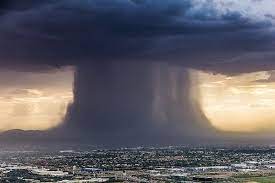Q. Explain the mechanism and occurrence of cloudburst in the context of the Indian subcontinent. Discuss two recent examples.
Ans:
Mechanism and Occurrence of Cloudburst:
A cloudburst refers to an intense and sudden rainfall event characterized by extremely heavy downpours over a short period of time, often resulting in flash floods, landslides, and other related hazards. Cloudbursts are typically caused by localized and convective weather conditions, where warm, moist air rises rapidly and condenses to form clouds. The rapid upward motion of air and the presence of atmospheric instability contribute to the intense rainfall associated with cloudbursts.

In the context of the Indian subcontinent, cloudbursts are often linked to the following factors:
- Topography: The diverse topography of the Indian subcontinent, which includes mountains, valleys, and coastal areas, plays a crucial role in the occurrence of cloudbursts. When moist air is forced to ascend rapidly due to the presence of mountains, it cools and condenses, leading to heavy rainfall.
- Monsoon Dynamics: The Indian subcontinent experiences a monsoon climate, characterized by distinct wet and dry seasons. During the monsoon, warm and moist air from the Indian Ocean is drawn over the landmass, leading to convective processes and the potential for cloudbursts.
- Temperature Contrasts: Temperature contrasts between land and water bodies, especially during the monsoon season, create favorable conditions for the formation of convective clouds and intense rainfall.
Two Recent Examples of Cloudbursts in India:
- Ladakh Cloudburst (August 2010): In August 2010, the Leh region of Ladakh, located in the northern part of India, experienced a devastating cloudburst. Intense rainfall occurred over a short period, leading to flash floods and massive mudslides. The cloudburst caused widespread damage to infrastructure, homes, and farmland. Several people lost their lives, and many were displaced. The rugged terrain of Ladakh exacerbated the impact of the cloudburst, leading to significant challenges in rescue and relief operations.
- Uttarakhand Cloudburst (July 2021): In July 2021, the state of Uttarakhand, situated in the Himalayan region of northern India, witnessed a cloudburst that triggered flash floods and landslides. The event occurred in the Chamoli district, affecting the Tapovan area. The cloudburst led to the rapid rise of the Rishi Ganga River, causing widespread destruction of infrastructure, hydroelectric projects, and roads. Several people were reported missing, and rescue operations were launched to save lives and provide assistance to affected communities.
Conclusion:
Cloudbursts are natural phenomena that can have significant and often catastrophic impacts on communities, especially in regions with complex topography and monsoonal weather patterns like the Indian subcontinent. Timely and accurate weather forecasting, early warning systems, and improved infrastructure resilience are crucial for mitigating the risks associated with cloudbursts and minimizing their adverse effects on lives and property.
Thanks for reading the answer to question: Explain the mechanism and occurrence of cloudburst in the context of the Indian subcontinent. Discuss two recent examples.
Read: